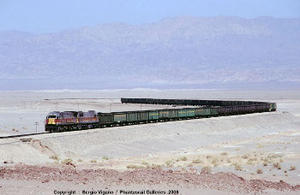Nuclear mattersMany ways to smuggle nukes into the United States
The United States focuses on scanning shipping containers for nuclear smuggling; with nearly 10 million cargo containers arriving in the United States by sea or on land each year, this is a difficult task; the GAO says this is not enough, and that the government must find ways to keep an eye on 13 million recreational boats and 110,000 fishing vessels which go in and out U.S. sea ports — and also on freight trains, which are often more than three kilometers long

Many freight trains are longer than this, and present their own security problems // Source: phantasrail.com
Terrorists bent on smuggling nuclear materials into the United States still have plenty of ways to do so. This is the conclusion of a report by the government’s watchdog.
To prevent nuclear smuggling, the U.S. government focuses its efforts on shipping containers. A Government Accountability Office (GAO) panel warns, however, that other modes of transport should be watched more closely for smuggling.
Caitlin Stier writes that at a hearing two weeks ago before the Senate homeland security committee, the panel highlighted several potential vulnerabilities, including border-crossing railcars, international air travel, and small boats.
“It is important to close these gaps because dangerous quantities of nuclear materials can be portable enough to be carried across borders by vehicles or pedestrians on most private aircraft or small boats,” Gene Aloise, director of the GAO’s natural resources and environment division, said in his testimony.
Detecting nuclear smuggling by such means will be a challenge. For example, it would involve keeping an eye on 13 million recreational boats and 110,000 fishing vessels, according to U.S. coastguard figures. Scrutinizing trains — often more than three kilometers long — with handheld scanners would also be difficult, and it is unfeasible to separate out suspect cars.
Efforts are currently being wasted on replacing existing detection technology at ports with newer but “questionably performing” radiation monitors, Aloise added.
